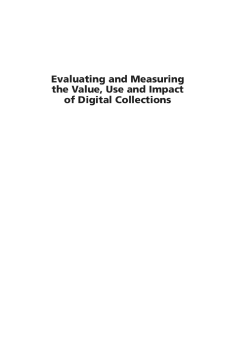
Additional Information
Book Details
Abstract
A huge investment has been made in digitizing scholarly and cultural heritage materials through initiatives based in museums, libraries and archives, as well as higher education institutions. The 'Digital Economy' is an important component of institutional planning, and much attention is given to the investment in digital projects and programmes. However, few initiatives have examined the actual use, value and impact of digital collections, and the role of digital collections in the changing information environment. As the creative, cultural and educational sector faces a period of restricted funding, it is timely to re-examine the use of the digital collections that have been created in the past twenty years, and to consider their value to the institutions that host them and to the communities of users they serve. This book brings together a group of international experts to consider the following key issues: What is the role of digital resources in the research life cycle? Do the arts and humanities face a 'data deluge'? How are digital collections to be sustained over the long term? How is use and impact to be assessed? What is the role of digital collections in the 'digital economy'? How is public engagement with digital cultural heritage materials to be assessed and supported? This book will be of interest to academics, librarians, archivists and the staff of cultural heritage organizations, as well as funders and other key stakeholders with an interest in the development and long term sustainability of digital collections.
Lorna Hughes is Deputy Director at the Centre for e-Research, King's College London.
"This book is important for all those involved in digitization programmes. Its main strength is that it covers libraries, archives and museums to give an overall perspective." - Journal of Librarianship and Information Science
"Evaluating value and impact is the Holy Grail for all involved in the provision of information. How do we know that we are making a difference? This book attempts to answer the question in a series of independently written but structured chapters covering the range of issues across the libraries, museums and archives sectors. The chapters form in effect a series of examples of how different institutions and sectors have approached digitisation, attempted to evaluate them and seek to enhance their value." - Managing Information
